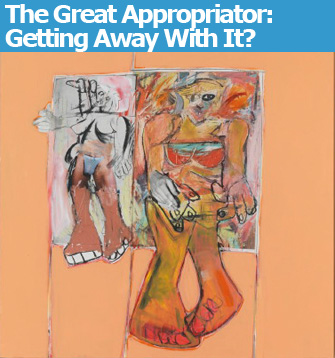 |
|
Richard Prince’s “Untitled (de Kooning)” (2009). |
The debate rages on about the appropriateness of appropriation in art and music, but when it comes to Richard Prince, I will definitely come down on the …
 |
|
Richard Prince’s “Untitled (de Kooning)” (2009). |
The debate rages on about the appropriateness of appropriation in art and music, but when it comes to Richard Prince, I will definitely come down on the anti side. I have never been able to understand the interest of (or why people would pay millions of dollars for) Prince’s rip-offs of the covers of pulp novels, for example, which he reproduces, blows up and adds a swish of paint to.
Two exhibitions currently on show in Paris have not raised my esteem for this “artist,” although “Richard Prince: American Prayer” at the Bibliothèque Nationale de France (François-Mitterrand site) is extremely interesting in one respect: it shows Prince to be an avid collector of books, manuscripts and autograph letters, and its selection from his collection offers a fascinating trip down memory lane for anyone of a certain age, with both the American and British first editions of works like Yoko Ono’s Grapefruit on display side by side, along with dozens of little gems of 20th-century literary history, such as the typed first page of J.D. Salinger’s novella Zooey, ready for publication in The New Yorker, complete with the additions and deletions of famed editor William Shawn.
A copy of Jack Kerouac’s The Town and the City is inscribed by the author to Carolyn Cassady: “With the deepest apologies I can offer for the fiasco, the foolish tragic Saturday of Neal’s birthday – all because I got drunk – Please forgive me Carolyn – It’ll never happen again.” What was the bad behavior behind this? On Neal Cassady’s birthday, Kerouac got Neal to go out partying with him by calling the Cassady house and claiming that he (Kerouac) had been arrested. The next morning the two men showed up at the house with a prostitute.
You can also see Vladimir Nabokov’s personal copy of the true first edition of Lolita, written in English and published in Paris by Maurice Girodias, as well as letters between Truman Capote and Perry Smith, one of the subjects of Capote’s In Cold Blood, while he was awaiting execution for murder.
It is highly appropriate for a library to offer such exhibits, and unusual for the staid National Library of France to present what might be deemed some rather racy material (although the library did stage a show of centuries worth of previously censored erotic materials from its collections a few years ago). The contents of a “house” built in the middle of the Prince exhibition are more problematic. Here we see the original artwork for the pulp novels Prince appropriates, mounted and framed along with the book jackets. The artists are given no credit – as is Prince’s habit –unless they happened to have signed their work, which many of them did not. Also on show are similar pieces called “Untitled (Almost Originals),” to which Prince has added some daubs of paint.
Not all artists take this lying down. Photographer Patrick Cariou, dozens of whose images of Rastafarians were given the Prince treatment, recently sued Prince and his gallery, Gagosian, for copyright infringement in New York, and won (the case is being appealed).
Collage artists are apparently worried about the effect of this ruling on their work, but what Prince does cannot be called collage, since the original works take center stage and are almost wholly visible. In the other Prince exhibition currently on show in Paris, “Richard Prince: de Kooning” at the Gagosian Gallery, Prince takes images of paintings by Willem de Kooning, draws over them a bit and defaces the human figures with cutout images from porn magazines, such as a penis in see-through mesh underpants.
Watching this short video (click on the “Richard Prince” poster) of Prince talking rather inarticulately about art will not impress you, but the man can’t be that stupid, since he’s making millions by messing around with his obsessions. Looks like fun. I wish we could all get away with it.
Bibliothèque Nationale de France-François-Mitterrand: Quai François-Mauriac, 75013 Paris. Métro: Quai de la Gare. RER C: Bibliothèque François-Mitterrand. Open Tuesday-Saturday, 10am-7pm; Sunday, 1pm-7pm. Admission: €7. Through June 26. www.bnf.fr
Gagosian Gallery: 4, rue de Ponthieu, 75008 Paris. Métro: Franklin D. Roosevelt. Tel.: 01 75 00 05 92. Open Tuesday-Saturday, 11am-7pm. Through May 21. www.gagosian.com
Reader Chris Lawrence writes: “Could not agree more about your criticism of Richard Prince and other appropriators (yes, we all steal from each other, but we must transmute the theft). It is only another indication of the shallowness of the art market that it needs to extol the virtues of the emperor’s new clothes.”
Reader Terry Seligman writes: “I’ve come to believe that contemporary art is more about questions than answers, and in that sense appropriation is valuable because it raises questions about ‘what is art?’ For example, given the difficulty of creating something entirely new, is it okay to borrow from an existing image or object in order to ‘repurpose’ (Prince), ‘remove’ (viz. Rauschenberg’s ‘Erased de Kooning’), or ‘retitle (Duchamp’s ‘Fountain’)? Food for thought! On the other hand, Koons got nailed for appropriating; maybe Prince will, too.’”
Reader Reaction: Click here to respond to this article (your response may be published on this page and is subject to editing).
Please support Paris Update by ordering books from Paris Update’s Amazon store at no extra cost. Click on your preferred Amazon location: U.K., France, U.S.
More reviews of Paris art shows.
© 2011 Paris Update
